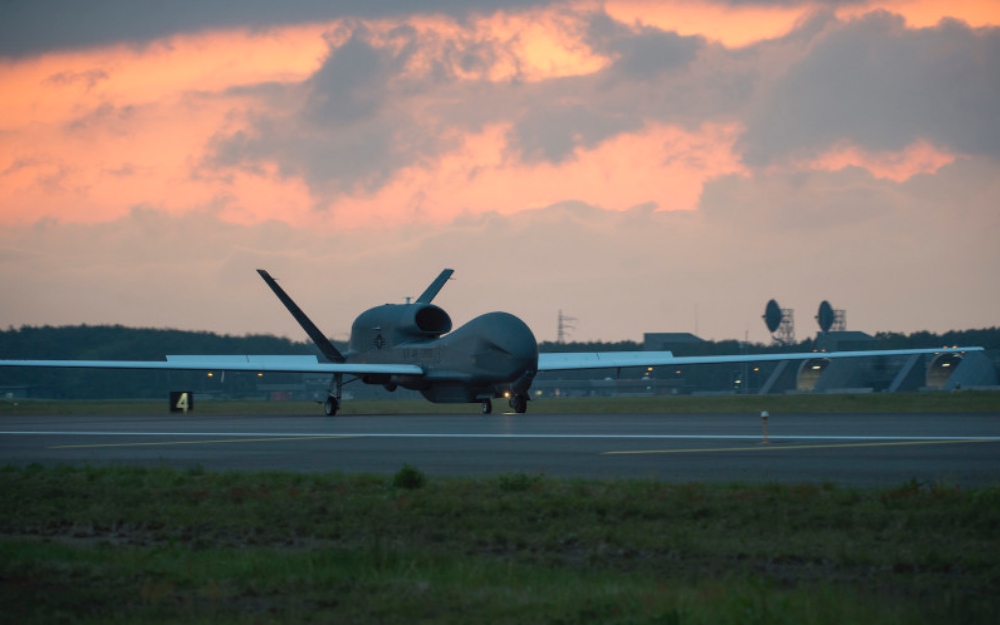
A U.S. RQ-4 Global Hawk drone lands at Misawa Air Base for a temporary intra-theater routine deployment in Japan on June 1, 2018
Just months after Iran shot down an expensive U.S. surveillance drone over the Strait of Hormuz, the Defense Department is weighing scrapping about two-thirds of the Air Force’s roughly three dozen Global Hawk unmanned aircraft as part of a shift toward building the new capabilities needed to counter China and Russia.
The Air Force has proposed retiring as many as 21 of its 35 RQ-4 Global Hawk high-altitude drones, which currently collect intelligence across the Middle East and elsewhere, as part of a series of steep cuts to legacy programs, current and former U.S. defense officials told Foreign Policy. The proposal has been submitted to the Office of the Secretary of Defense for review as part of annual budget negotiations.
“The Air Force continues to refine its budget submission,” Air Force spokeswoman Ann Stefanek said. “We don’t expect details to be available until the President’s Budget is submitted to Congress in February 2020.”
The proposed cut is part of the Pentagon’s shift from the counterterrorism fight of the last few decades toward so-called great-power threats from China and Russia. The strategy was laid out in the Pentagon’s guiding doctrine, the National Defense Strategy, rolled out by then-Defense Secretary James Mattis in January 2018.
Both China and Russia are increasingly able to challenge the U.S. military’s superiority through a wide variety of sophisticated missiles, air defenses, and electronic capabilities that could destroy key U.S. and allied forces—even U.S. aircraft carriers.
The Pentagon’s challenge, then, is to invest in building next-generation systems that can penetrate Chinese and Russian defenses—the new B-21 stealth bomber, hypersonic missiles, and others. But to do so, the department needs cash. So, the Pentagon, led by Defense Secretary Mark Esper, has embarked on an effort to review legacy programs to see which ones it can live without.
“The U.S. military will need to undergo dramatic change to prepare for possible attacks from China or Russia,” wrote Elbridge Colby, a former Pentagon official, in a recent feature for Foreign Policy.
Esper’s guidance states that “no reform is too small, too bold, or too controversial to be considered,” then-Acting Air Force Secretary Matthew Donovan said in September, noting that the Air Force “is leading the way with bold and likely controversial changes to our future budgets.”
“We need to shift funding and allegiance from legacy programs we can no longer afford due to their incompatibility with future battlefields and into the capabilities and systems that the nation requires for victory,” Donovan said. “There’s no way around it.”
The Global Hawk, which first deployed in 2001 and is built by Northrop Grumman, is one of the logical cuts, experts said. As a small fleet—just three dozen planes—the aircraft is difficult to maintain due to scarcity of parts, but more importantly it is vulnerable to enemy fire in hostile airspace. With a wingspan of 131 feet, it is easily spotted by radar and has no defensive systems.
“It was well suited to go against terrorists, but against a threat like China it just won’t survive,” said Loren Thompson of the Lexington Institute, adding that flying a Global Hawk over Chinese airspace would be “suicidal.”
Photo: U.S. AIR FORCE PHOTO BY STAFF SGT. DEANA HEITZMAN
Source: Foreign Policy
